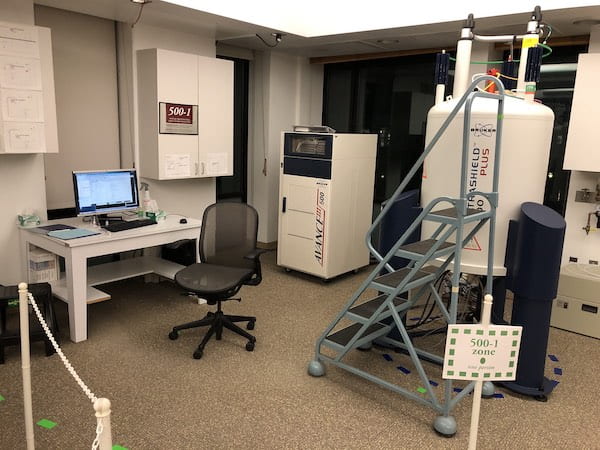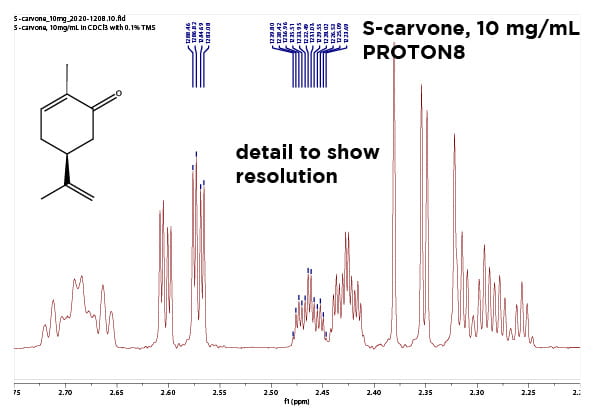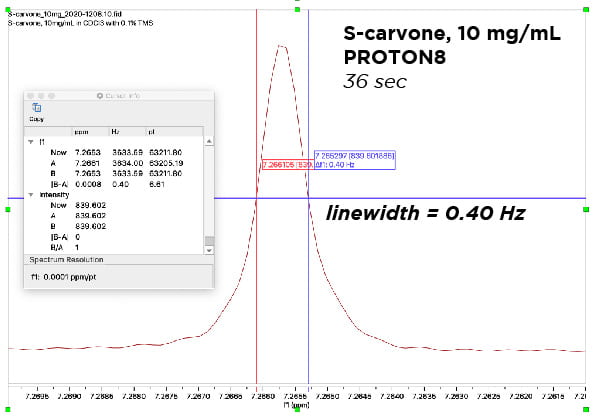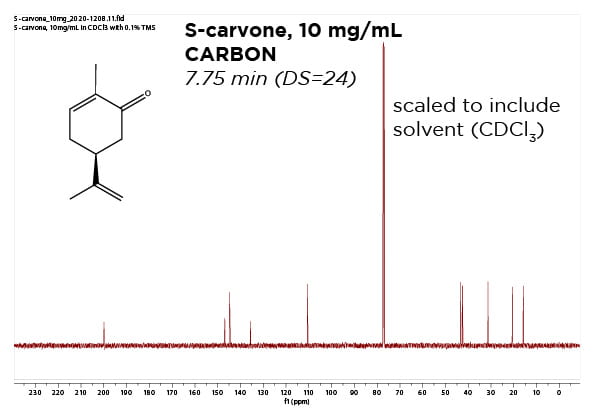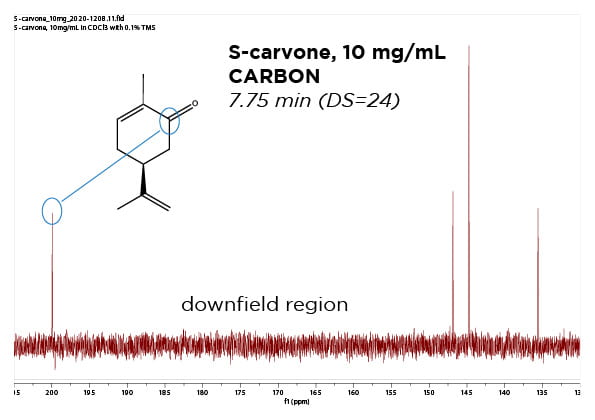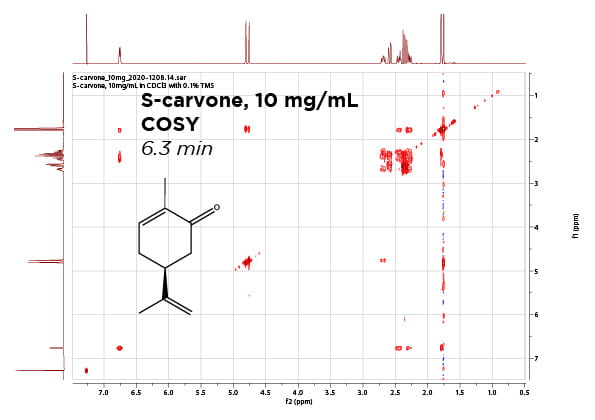500-1 is now available!
The NMR Facility has been approved to increase the maximum room occupancy of the Searle lab to FOUR people, which means we can bring 500-1 online. Yay !!
SEPARATE USAGE MODES:
The immediate benefit for Searle NMR users is the separation of usage modes between 500-1 and 500-2. They are now:
- 500-1: Walkup spectroscopy (less than 20 minutes) all the time, NO RESERVATIONS, room temperature experiments only
- 500-2: Intensive spectroscopy (up to five hours in a sitting between 8:00 AM and 11:00 PM), RESERVATIONS REQUIRED, VT experiments OK for VT-trained users
New Probe: BBO, similar to 500-2’s
500-1 is now configured with a different probe than what it has had in recent years. The new one is a “broadband observe (BBO)” type, in which the non-1H coil is the more sensitive one, and it can be tuned to a wide range of frequencies. This means it will deliver better 13C sensitivity than before, though 1H sensitivity will be reduced somewhat. Further, it can be used for walkup spectroscopy on non-13C nuclea as well, including 31P, 11B, and others. (It may need to have an additional tweak to get it to do 19F; I’ll need to consult with Bruker about it).
Compare to Other Spectrometers with Carvone
When seeking a spectrometer for your experiment, it helps to have an idea for what data may look like given a particular sample. To help you compare instrument performance, I’ve prepared two sealed samples that will be run on all our spectrometers: S-carvone (MW 150) in CDCl3, one sample at 10.0 mg in 1.0 mL, and one at 1.0 mg in 1.0 mL. Below we see results with the 10 mg/mL sample from several experiments, all using the DEFAULT acquisition parameters. Paper printouts of these spectra are posted next to the 500-1 workstation.
You can see that 10 mg is plenty to yield a good 13C 1D in under eight minutes. Remember:
• Your signal strength depends on the MOLAR concentration of sample. So if you have 10 mg in 1.0 mL, and your molecule is 300 MW, then you’ll see HALF the amount of signal you see here.
• If you use 10 mg sample of 150 MW, but it’s dissolved in only 0.5 mL, your signal will DOUBLE compared to the 1.0 mL sample
• If you’re observing half this level of signal (the signal-to-noise ratio, S/N) and want to bring it up to this level by adjusting the number of scans, NS, you’ll need to multiply NS by FOUR. Doubling S/N requires four times as many scans. Increasing S/N by a factor of four requires 16 times as many scans.
All of these experiments can be acquired in the time allowed (except the HMBC, which you’d need a couple extra minutes to lock, shim, tune, etc.).
01_PROTON8, 36 seconds
overview spectrum
expanded to show resolution; 1.4 Hz couplings easily resolved, measured
linewidth of CHCl3 achieved with topshim, including “tune” of Z-X-Y-XZ-YZ-Z = 0.40 Hz
04_CARBON, 7.75 min
overview spectrum, scaled to include top of residual CHCl3
expansion of downfield region of 13C spectrum, including normally weak signals from 13C atoms with no 1H bound
05_DEPT135, 4.75 min
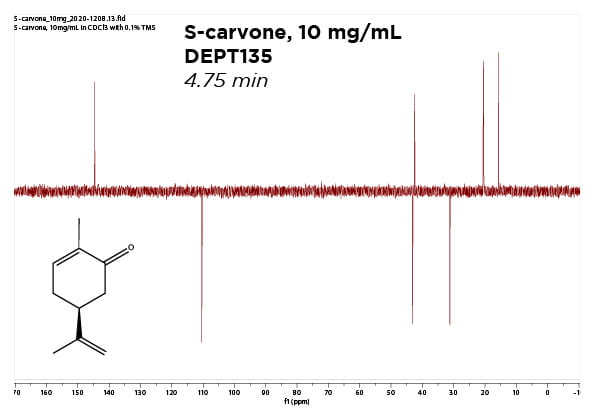
13C DEPT135 spectrum, CH3 and CH positive, CH2 negative; 1H magnetization transfer makes DEPT135 more sensitive than regular 13C 1D.
10_COSY, 6.3 min
11_HSQC, 15.5 min
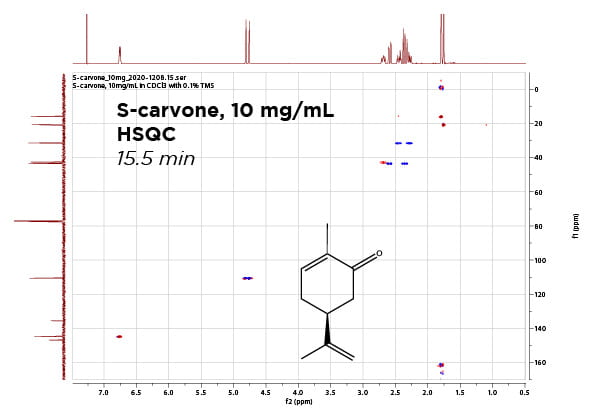
2D 1H-13C HSQC spectrum of S-carvone 10mg/mL, “edited” type with pos/neg contours for CH and CH3 / CH2 peaks
12_HMBC, 19.5 min
13_HSQC-TOCSY, 16 min
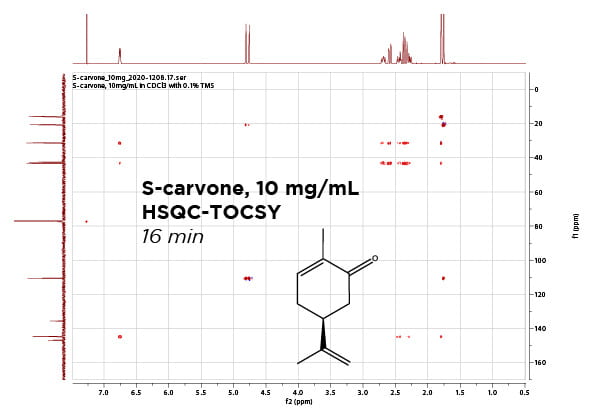
2D HSQC-TOCSY of S-carvone 10mg/mL – like an HSQC where each 13C signal has a crosspeak to the 1h bound to it PLUS all the 1Hs in that 1H’s TOCSY spin system
(The HSQC-TOCSY will be discussed more in a future blog post. But go ahead and try it! It’s set up on all the instruments now.)

